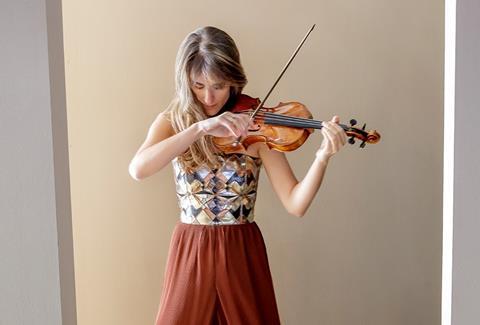Violinist Francesca Dego guides us through the finale to Mozart’s Violin Concerto no.4, illustrating how working with an orchestra can help maintain ‘the big picture’

The following extract is from The Strad’s January 2022 issue Masterclass feature on Mozart Violin Concerto no.4 with Francesca Dego. To read it in full, click here to subscribe and login. The January 2022 digital magazine and print edition are on sale now
The first movements of Mozart’s violin concertos are so often used as audition pieces that sometimes I think people forget the pieces are longer than that! Last movements are frequently the most straightforward and happy, and to me this one in particular is incredibly special. Mozart just pours out idea after idea, and there are so many possible interpretations. It is one of my favourite movements to play with orchestra.
Too often violinists seem to be walking on eggshells when they play Mozart, because they have been told so many rules about what they can and cannot do that they only learn to follow instructions, instead of feeling the music for themselves. They often focus all their attention on playing exactly what is written, with clean shifts, articulate bow changes and good string-crossings and intonation, and their playing moves between sounding sheepish and even more hidden. That can put a real barrier between them and the music.
It’s important to have a scholarly understanding of the music, but you also have to be able to play what is musical, not just what is ‘correct’. One way not to be frightened of Mozart is to play really loudly in the fortes, to bring out the chiaroscuro effect in his writing. Obviously you don’t want to sound heavy or vulgar, but the orchestration is rich and there is a lot going on, so you have to know how to dip in and out of that. Mozart’s scores can look quite empty dynamically, but the music should be full of shapes in between each piano and forte.
Listen: The Strad Podcast Episode #4: Francesca Dego on playing ‘Il Cannone’
Read: ‘Music and Mozart have been life savers’ - The Engegård Quartet
Working with a conductor
Sometimes violin teachers focus on the technical difficulties of a piece at the expense of the bigger picture, so it can be useful and interesting to work on this music with a conductor who does not have any violinistic technical barriers in front of them. That may mean that they ask you to do things that are uncomfortable, but that make more sense musically.
Working on this concerto with Roger Norrington has really helped me to change the way that I think about phrasing and articulation, even though it isn’t easy to do everything he asks, especially where tempo is concerned! He is 87 now, and he has such a freshness of approach.
Rapport with the orchestra
There are many moments of dialogue between the violin and the orchestra in this movement, especially with the woodwinds, which Mozart always uses in a wonderfully active and important way. As the soloist, it’s important to communicate clearly, to show what is happening and to bring the other musicians with you. For instance, the Allegro ma non troppo first comes in bar 15, then again in bar 85 and finally from 224. I like to communicate with them that I want a feeling of waves and lightness each time, with a biting acciaccatura.
In the up-beat to bar 32, I sometimes play an accent to emphasise that I’m interrupting and repeating what the violins have just done, to give more direction, interest and colour. For the section of intense dialogue with the orchestra from bar 37, agree in advance how you are going to interpret this, and play very clearly, because too often the soloist and the orchestra do their own separate thing. I then like to diminuendo into bar 43, so that it’s a surprise when the orchestra enters in forte. The music becomes so much more alive when you work with an orchestra to shape every half-bar and bring out little surprises in response to what you are playing.











































No comments yet